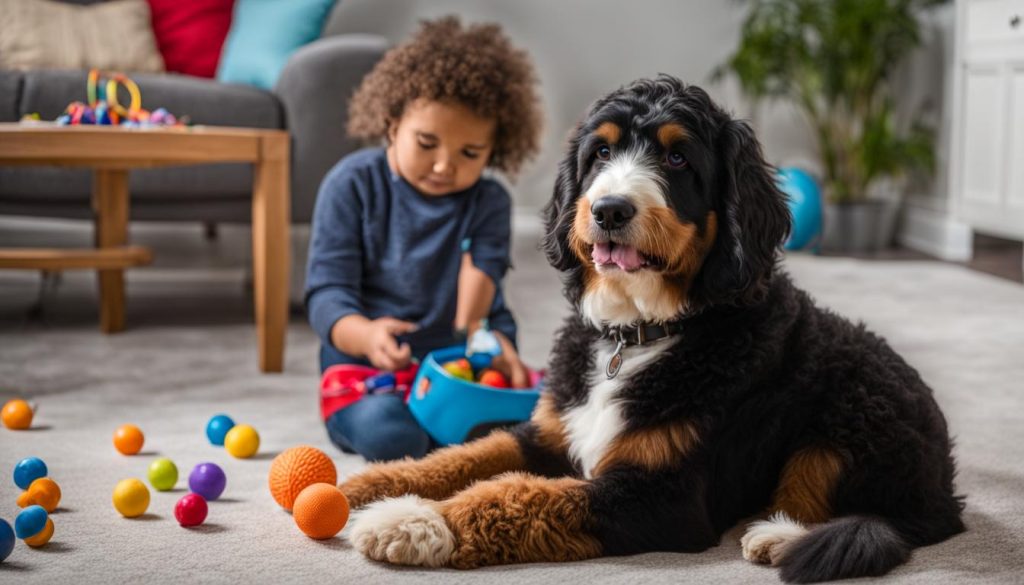Welcome to my guide on Bernedoodle training! If you have a Bernedoodle, you know what delightful and affectionate companions they can be. However, training them can be a bit of a challenge. Bernedoodles are known for their stubbornness and hesitance in new situations.
In this article, I will share essential Bernedoodle training tips that will help you establish a strong bond with your furry friend and ensure a well-behaved and happy pooch. From obedience training to potty training, leash training to behavioral training, we will cover it all.
Whether you have a Bernedoodle puppy or an adult Bernedoodle, these training techniques will provide you with effective methods to shape their behavior and foster a positive training experience. We will also discuss common issues that Bernedoodle owners face during training and provide guidance on when to seek professional help.
Bernedoodle Training
- Start training your Bernedoodle as early as possible to establish routines and boundaries.
- Four popular training methods for Bernedoodles are positive reinforcement, clicker training, mirror training, and relationship-based training.
- Essential training items for Bernedoodles include treats, toys, a collar or harness, and a crate.
- Common training issues with Bernedoodles include food stealing, jumping on people, excessive barking, separation anxiety, leash pulling, counter surfing, stranger anxiety, and destructive behaviors.
- Seek professional help if you encounter complex or severe behavior issues.
When to Start Training Your Pup
Training your Bernedoodle puppy is a crucial step in shaping their behavior and ensuring they grow up to be well-mannered adults. As a responsible owner, it’s important to start their training as early as possible to establish routines and boundaries. Early training sets the foundation for a happy and well-adjusted Bernedoodle.
During the first few weeks of your puppy’s life, they are highly receptive to learning and adapting to new experiences. This is the ideal time to start their socialization and obedience training. Socialization helps your Bernedoodle become comfortable and confident in various environments and around different people and animals. By exposing them to different sights, sounds, and experiences early on, you can help prevent fear-based behaviors and promote their overall well-being.
Obedience training should also be initiated at this stage. Start with basic commands such as sit, stay, and come. Be patient and consistent in your training approach, using positive reinforcement techniques like treats and praise to reward good behavior. This helps your puppy understand what behaviors are desired and encourages them to repeat those behaviors in the future.
It’s worth noting that while puppies can start training at an early age, their attention span may be limited, so keep training sessions short and engaging. Aim for multiple short sessions throughout the day to keep your puppy focused and prevent them from becoming overwhelmed.
Remember, Bernedoodle training should be a positive and enjoyable experience for both of you. Celebrate small successes along the way, and don’t be discouraged by occasional setbacks. Building a strong bond with your puppy through early training lays the foundation for a lifetime of companionship and mutual understanding. Start training your Bernedoodle pup today and watch them grow into a well-behaved and happy member of your family.
The Best Way to Train Your Bernedoodle: 4 Popular Methods
When it comes to training your Bernedoodle, there are multiple methods you can use to ensure a positive and effective training experience. In this section, I will discuss four popular training methods that have proven to be successful in shaping Bernedoodle behavior: positive reinforcement training, clicker training, mirror training, and relationship-based training.
1. Positive Reinforcement Training
Positive reinforcement training focuses on rewarding desired behaviors rather than punishing unwanted behaviors. This method utilizes rewards, such as treats or praise, to encourage your Bernedoodle to exhibit the desired behavior. By reinforcing good behavior consistently, you can help your Bernedoodle understand what is expected of them and motivate them to continue behaving appropriately. Remember to be patient and consistent during the training process.
2. Clicker Training
Clicker training is a form of positive reinforcement training that uses a sound cue, typically a clicker, to mark the exact moment your Bernedoodle exhibits the desired behavior. The clicker serves as a reward marker, signaling to your dog that they have done something right. The sound of the clicker should be consistently followed by a reward, reinforcing the positive behavior. Clicker training can be an effective way to teach your Bernedoodle specific commands and tricks.
3. Mirror Training
Mirror training is an interesting approach that involves using your own actions as a model for your Bernedoodle to imitate. By demonstrating the desired behavior yourself, your dog can observe and learn from your actions. For example, if you want to teach your Bernedoodle how to sit, you can sit in front of them and repeat the command along with the action. This method relies on the dog’s ability to mirror or imitate their owner’s behavior, making it an effective training technique for some Bernedoodles.
4. Relationship-Based Training
Relationship-based training emphasizes building a strong bond and trust between you and your Bernedoodle. This method focuses on positive reinforcement, clear communication, and understanding your dog’s needs and preferences. By establishing a positive and trusting relationship, you can create a solid foundation for training your Bernedoodle effectively. Building a strong bond with your dog can enhance their motivation to learn and obey commands.

Using any of these training methods, or a combination of them, can help you establish a positive and productive training routine with your Bernedoodle. Remember that consistency, patience, and positive reinforcement are key to successful training outcomes. Find the approach that works best for your Bernedoodle’s unique personality and always prioritize their welfare and well-being throughout the training process.
Training Items You Absolutely Need for Your Doodle
When it comes to Bernedoodle training, having the right tools can make all the difference. Here are some essential items that will help you effectively train your furry companion:
Training Treats
Training treats are essential for positive reinforcement during training sessions. Choose small, bite-sized treats that are delicious and enticing to your Bernedoodle. These treats will motivate your dog and reinforce good behavior.
Training Toys
Training toys serve a dual purpose by keeping your Bernedoodle mentally stimulated while providing a reward during training. Interactive toys, such as puzzle toys or treat-dispensing toys, engage your dog’s mind and make training sessions more enjoyable.
Training Collar
A training collar is a valuable tool for leash training your Bernedoodle. Opt for a collar that fits comfortably and securely around your dog’s neck. Remember to choose a collar suitable for your dog’s size and weight.
Training Harness
If your Bernedoodle tends to pull on the leash, consider using a training harness instead of a collar. A harness provides better control and reduces the risk of injury to your dog’s neck. Look for a harness with adjustable straps for a snug and secure fit.
Crate for Crate Training
For crate training, a sturdy and comfortable crate is essential. Choose a crate that is appropriate for your Bernedoodle’s size, allowing enough space for them to stand, turn around, and lie down comfortably. Consider using a crate with a divider for your Bernedoodle puppy to accommodate their growth.
Incorporating these training items into your Bernedoodle’s training routine will help create a positive learning experience and ensure successful results. Remember to use positive reinforcement and consistency to create a strong bond with your furry friend.
Bernedoodle Training 101: 8 Common Issues and How to Tackle Them
While Bernedoodles are generally well-behaved, like any other dog breed, they can encounter some common training challenges. In this section, I will discuss eight common issues that Bernedoodle owners may face during training and provide tips and strategies for effectively addressing them. Let’s dive in!
1. Food Stealing
One common behavior in Bernedoodles is food stealing. To tackle this issue, be proactive in setting boundaries and establishing clear rules around mealtimes. Ensure that your Bernedoodle has their own designated feeding area and avoid leaving food unattended. Consistently reinforce the idea that stealing food is not acceptable by redirecting their attention and providing positive alternatives.
2. Jumping on People
Jumping on people can be a challenging behavior to address, especially since Bernedoodles have a tendency to be playful and energetic. To discourage jumping, consistently ignore the behavior and reward your Bernedoodle when they have all four paws on the ground. Redirect their energy by engaging them in an alternative activity, such as playing with a toy or practicing basic commands.
3. Excessive Barking
If your Bernedoodle tends to bark excessively, it’s important to address the underlying cause. Identify the trigger for their barking and work on desensitizing them to that particular stimulus. Training them to respond to a “quiet” command can also be helpful in curbing excessive barking. Consistency and positive reinforcement are key in addressing this issue.
4. Separation Anxiety
Sensitive by nature, Bernedoodles may develop separation anxiety if not properly trained and gradually acclimated to being alone. Start by leaving them alone for short periods and gradually increase the duration over time. Create a comfortable and secure space for them to minimize anxiety. Introduce positive associations with being alone, such as leaving them with a special toy or treat.
5. Leash Pulling
When it comes to leash pulling, Bernedoodles’ strength can make it challenging to control them during walks. Use positive reinforcement techniques, like rewarding them for walking alongside you without pulling, and incorporate consistent leash training exercises. Consider using a front-clip harness that discourages pulling and reinforces good walking behavior.
6. Counter Surfing
Counter surfing, or the habit of your Bernedoodle jumping up on kitchen counters or tables to grab food or items, can be frustrating. Establish clear boundaries by consistently redirecting their attention away from countertops and rewarding them for appropriate behavior. Ensure that counters are clear of any temptations, such as food or enticing objects.
7. Stranger Anxiety
Bernedoodles are generally friendly and sociable, but some may exhibit stranger anxiety. Socialization is crucial in addressing this issue. Gradually expose your Bernedoodle to new people and environments, providing positive experiences and rewards. Encourage calm behavior and reward them for remaining relaxed and friendly around strangers.
8. Destructive Behaviors
Destructive behaviors can occur when Bernedoodles are bored or anxious. To prevent destructive behaviors, provide mental and physical stimulation through interactive toys, puzzle feeders, and regular exercise. Ensure that your Bernedoodle has a safe and designated space where they can relax or engage in appropriate chewing.
By understanding and addressing these common training issues, you can foster a positive and well-behaved Bernedoodle. Remember to be patient, consistent, and use positive reinforcement techniques to effectively tackle these challenges.

When To Get Professional Help
In some cases, training your Bernedoodle may become challenging, especially when dealing with complex or severe behavior issues. In such situations, seeking professional help from Bernedoodle training professionals can make a significant difference in achieving the best outcomes for your furry companion. Whether you need guidance in obedience training, addressing behavioral problems, or specialized assistance, dog trainers and Bernedoodle behaviorists are equipped to handle these situations with expertise and experience.
Professional trainers and behaviorists understand the unique needs and characteristics of Bernedoodles and can tailor their training methods accordingly. They can provide valuable insights, personalized training plans, and effective techniques to modify your Bernedoodle’s behavior and ensure a positive training experience for both you and your dog.
By working with Bernedoodle training professionals, you can gain a deeper understanding of your dog’s behaviors, develop stronger communication and bonding, and address any specific challenges you may be facing. Whether it’s leash pulling, separation anxiety, or socialization issues, these professionals have the knowledge and tools to help you and your Bernedoodle overcome these hurdles.
How to Find the Right Professional
When looking for Bernedoodle training professionals, consider the following factors:
- Experience: Look for trainers or behaviorists with a proven track record of successfully training Bernedoodles.
- Reputation: Read reviews and testimonials to gauge the quality of their services and the satisfaction of previous clients.
- Training Methods: Ensure that the professional’s training methods align with your preferences and values, such as positive reinforcement-based training.
- Certifications: Check if the professional holds any relevant certifications or memberships in recognized training organizations.
- Personal Connection: Schedule a consultation or interview with the professional to assess their rapport with you and your Bernedoodle.
Remember, seeking professional help is not a sign of failure but rather a proactive step towards providing the best training for your Bernedoodle. These experts can guide you through the training process, offer invaluable advice, and help you overcome any obstacles that may arise along the way.
By involving Bernedoodle training professionals in your dog’s training journey, you can ensure that your Bernedoodle receives the specialized attention and care it needs to develop into a well-mannered and happy companion.
Conclusion
In conclusion, Bernedoodle training is a vital aspect of nurturing a happy and well-behaved dog. By starting the training process early and utilizing effective methods, you can ensure that your Bernedoodle develops good behaviors and flourishes in your home. Patience, consistency, and positive reinforcement are key elements in unlocking your Bernedoodle’s potential for a joyful and obedient life alongside you.
Throughout this guide, we have explored various training techniques, from positive reinforcement and clicker training to mirror training and relationship-based approaches. Understanding the importance of socialization and establishing boundaries early on can greatly contribute to a well-adjusted adult Bernedoodle.
While training your Bernedoodle, it is important to consider the necessary training items such as treats, toys, and appropriate collar or harness for leash training. These tools can enhance the effectiveness of training sessions and facilitate better outcomes.
If you encounter common training challenges like food stealing, jumping on people, excessive barking, separation anxiety, leash pulling, counter surfing, stranger anxiety, or destructive behaviors, don’t worry. With the tips and strategies provided in this guide, you can tackle these issues effectively and strengthen the bond with your furry friend.
Remember, if you ever find yourself facing complex or severe behavior issues, seeking professional help from trained trainers or behaviorists is a wise decision. They possess the expertise and knowledge to address specific challenges and ensure the best results for your Bernedoodle’s training journey.
FAQ
When should I start training my Bernedoodle puppy?
It is important to start training your Bernedoodle puppy as early as possible to establish routines and boundaries. The first few weeks are crucial for socialization and obedience training, which contribute to a well-behaved adult Bernedoodle.
What are the popular methods for training Bernedoodles?
The four popular methods for training Bernedoodles are positive reinforcement, clicker training, mirror training, and relationship-based training. Positive reinforcement focuses on rewarding desired behaviors, while clicker training uses a sound cue as a reward marker. Mirror training encourages the dog to mimic the owner’s actions, and relationship-based training emphasizes building a strong bond with the dog based on trust and understanding.
What training items do I need for my Bernedoodle?
Essential training items for Bernedoodles include training treats, toys, a collar or harness for leash training, and a crate for crate training. These tools can enhance the effectiveness of training sessions and improve overall training outcomes.
What are some common training issues with Bernedoodles and how can I address them?
Common training issues with Bernedoodles include food stealing, jumping on people, excessive barking, separation anxiety, leash pulling, counter surfing, stranger anxiety, and destructive behaviors. We will provide tips and strategies for addressing these issues effectively.
When should I seek professional help for Bernedoodle training?
It may be necessary to seek professional help for Bernedoodle training in cases of complex or severe behavior issues that require specialized expertise. Knowing when to get professional help is important for achieving the best results in your Bernedoodle’s training journey.






